Scouting the Enemy: Anaheim’s penalty kill

By Mike Pfeil
7 years agoThe Anaheim Ducks’ penalty kill is a riddle, wrapped in an enigma, wrapped in an awful jersey. From a goal, shot, and expected goals perspective, it’s actually below average in many categories. All the more remarkable is the fact that they finished the season fourth in the league with a 84.7% penalty kill. Systemically versus the Calgary Flames this year it’s been incredibly frustrating to watch as the Flames are unable at times to really produce anything.
From a pure systems perspective it’s been incredibly frustrating to watch it shut down the Calgary Flames as the hometown heroes have been unable at times to really produce anything consistently at 5v4. Ignore 5v3 because it’s a literal crapshoot.
More recently, we saw the ebb and flow of some success and a team marred by an inability to setup or enter the zone in the Flames final two games against the Ducks at the end of the season. Kris Versteeg’s two-goal showing on the April 2 game was really the only bright spot in terms of power play success against Anaheim, besides the success in December which saw an 8-3 routing including two power play goals that evening.
For this investigation, I used footage from three recent games for Anaheim:
The goal was to get a rough idea of what Calgary was going to encounter in the first round. When it comes to evaluating the results of the Ducks’ PK as a whole this season, the results aren’t all that impressive in many regards – especially when it comes to rates against (4v5 data via
When it comes to evaluating the results of the Ducks’ PK as a whole this season, the results aren’t all that impressive in many regards – especially when it comes to rates against (4v5 data via Corsica Hockey):
| Stat | CA60 | FA60 | SA60 | xGA60 | GA60 | xGA | GA |
| Results | 89.91 | 70.82 | 48.66 | 7.07 | 4.48 | 60 | 38 |
| League Rank (4v5) | 17th | 24th | 17th | 28th | 2nd | 30th | 11th |
The first and most apparent red flags are the disparity between expected goal metrics (xGA60 and xGA) and actual goals against metrics. Within Manny Perry’s xG model on Corsica, the Ducks’ 4v5 results didn’t fare as well as one would expect. For context, only Arizona and Buffalo were worse in xGA60 than Anaheim. It’s also worth noting that Calgary was 17th in xGA and 8th in xGA60 at 4v5 this season per Manny’s model.
The next red flag is how many shots – be it blocked, missed, or on net – per 60 minutes of 4v5 TOI the Ducks surrendered. This could be a byproduct of how often they were shorthanded – a league-leading 509.2 minutes at 4v5 – or it could be an overall systemic issue, but at a high-level view, it’s suspect. Regardless, there’s a lot to review in terms of how the Ducks have operated recently and some general themes in their play against Calgary.
Player usage – units/pairings
When healthy, the Ducks boast some capable units with offensive upside and puck-moving prowess. Even though this is a Randy Carlyle team, there is an indication that playing skilled players in the role is a critical element at play here. Via
Via Left Wing Lock we have the most frequent tandems and pairings used all season for Anaheim:
| Forward One | Forward Two | Defenseman One | Defenseman Two | Frequency of Deployment |
| Ryan Getzlaf | Ryan Kesler | Josh Manson | Hampus Lindholm | 6.1% |
| Ryan Getzlaf | Ryan Kesler | Cam Fowler | Sami Vatanen | 5.2% |
| Ryan Kesler | Jakob Silfverberg | Josh Manson | Hampus Lindholm | 4.5% |
| Ryan Kesler | Jakob Silfverberg | Cam Fowler | Sami Vatanen | 4.2% |
| Ryan Kesler | Antoine Vermette | Josh Manson | Hampus Lindholm | 3.4% |
| Ryan Kesler | Antoine Vermette | Cam Fowler | Sami Vatanen | 3% |
| Ryan Kesler | Jakob Silfverberg | Cam Fowler | Josh Manson | 2.9% |
| Andew Cogliano | Logan Shaw | Josh Manson | Hampus Lindholm | 2.6% |
| Ryan Getzlaf | Ryan Kesler | Kevin Bieksa | Cam Fowler | 2.3% |
| Ryan Kesler | Antoine Vermette | Cam Fowler | Josh Manson | 1.8% |
Injuries as of late have jostled the defensive pairings in all situations, but one thing is pretty certain: there won’t be any Cam Fowler for awhile. That means that the Flames will likely encounter a pairing of Manson and Lindholm as the “D1” pairing. From there the second unit could see a variety of combinations, including:
- Bieksa with Korbinian Holzer (frequency of 8.3% through the Ducks’ most recent three GP)
- Shea Theodore with Brandon Montour (frequency of 5% through the Ducks’ most recent three GP)
- Bieksa with Theodore
- Manson with Vatanen
There’s a large number of combinations used lately which makes it impossible to gauge how Carlyle and his coaching staff will set out to suppress the Flames’ powerplay. In terms of forward groups, given the last three GP and the historical data, there doesn’t appear to be any major changes – though look to Nate Thompson and Chris Wagner likely being a PK2/PK3 unit depending on how forwards are utilized over the first couple games of round one.
Neutral Zone: Entry suppression and forecheck
One of the most obvious characteristics of the Ducks’ PK that the Flames have seen first hand is the incredibly aggressive play in the neutral zone.
There are two components to what the Ducks do well from what I’ve been able to find: First, it’s elements of their forecheck that make it difficult for the opposition’s power play to break out and transition from their zone through the neutral zone towards the offensive zone (against Edmonton on April 1):
F1 pressures the puck carrier, funnelling them to the Ducks’ F2, who is set up with their defensemen ready to break up the entry. From there it gives them an opportunity to push back, making it difficult for the Oilers to regroup and enter the zone, which results in an offside. The chaos created in the neutral zone impedes any chance of a structured attack for the Oilers.
Again we see a similar approach to how the Ducks congest and forecheck with passive pressure to obstruct an on the rush attack and force a stoppage in play (against Calgary on April 2):

When it comes to the neutral zone you have to find ways to control it. The Ducks in the last two games versus Calgary have done a fantastic job of making it difficult to get through there. F1 shadows and cuts the ice in half, but to make sure the passing lane is taken away to the puck side player. This gives F2 (Wagner) the opportunity to step up into the pass and break it up. When reviewing this with Rachel Doerrie, there was the following recommendation to alleviate this issue:
To combat it, Calgary needs to bring their swinging forward off the boards, send the weak side forward in the NZ across to near side. Pass to streaking forward in DZ and the he quickly moves puck to player streaking to near side. Entry = (Y)
There are also the times when a Ducks forechecker – in this case Cogliano – strips the puck and creates an offensive situation for Anaheim and eventually an offensive zone faceoff (against Calgary on April 4):

This is what makes part of their neutral zone strategy so frustrating for the Flames and for fans. It’s not completely perfect, as is no team’s forecheck and neutral zone play, but it’s ideal in the current NHL.
It all feeds into the next element of the neutral zone schema the Ducks utilize which includes outright suppression of entries, an area the Flames have struggled with at times this season.
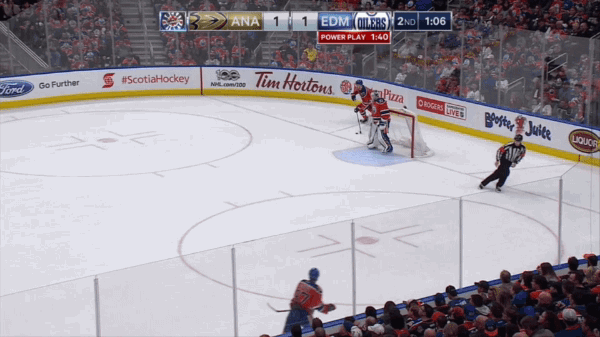
Attempting the stretch pass, Edmonton is completely stopped from entering Anaheim’s end. Both F1 and F2 come in to assist D1 on the entry prevention.
From there they regain possession and clear the puck down the ice, eating more time off the clock. It’s incredibly simple on first glance, but entry suppression is something to be coveted.

Against the Oilers again we see the Ducks making it impossible for them to enter the zone cleanly and set up. John Gibson corrals the puck, allowing for a quick dump down the ice forcing the Oilers to regroup once more before the end of their power play.
With that, the penalty killing forwards can then begin to change or start again on the forecheck.
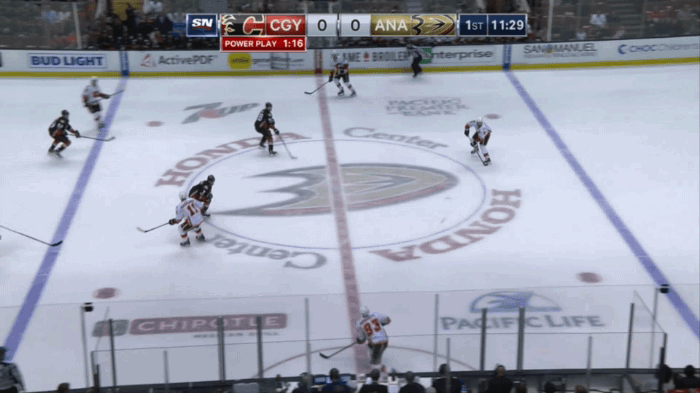
Sam Bennett is unable to handle the pass on his entry which is immediately pounced on as the Anaheim penalty killers transition back up ice to force the Flames’ power play to regroup yet again. Both F1 and F2 engage as soon as D2 has prevented Bennett’s entry. If the Flames hope to capitalize on the power play it’s going to take some strategy in breaking through with possession to set up.
A good example of Calgary finding success against this was Kris Versteeg’s first power play goal in the April 2 game in Calgary:
There’s a lot to be said about how the Ducks situate themselves in the neutral zone. Initially starting as a passive 1-3 formation, 33 (Silfverberg) and Kesler appear to switch up into a retreating box on the pass to Gaudreau as he transitions through the NZ as the puck carrier. This gives Ferland an easy entry and time to allow the Flames’ top PP unit time to set up. Silfverberg has the opportunity to take the body to Versteeg but gives him enough room to get to Gaudreau down low.
With Gaudreau able to work and throw a pass to Brodie at the point, the Ducks’ PK unit is now positioned in the high-danger area and starts to disperse back into the formation of their wedge+1. As F1 (Kesler) comes across to pressure Versteeg, he shoots and scores. Both defensemen are in position with Manson on Ferland in front and Fowler giving Bernier as much clear sight as possible on the shooter.
Defensive zone play and shutting things down
So if play happens in the Ducks’ zone, what traits and patterns can possibly expect from them? One thing worth drawing attention to – within reason because it’s not the end all, be all – is faceoffs. It’s becoming more and more apparent that a faceoff victory might be a team effort more than an individual effort, as illustrated by how the Ducks handle defensive zone faceoffs on the PK:
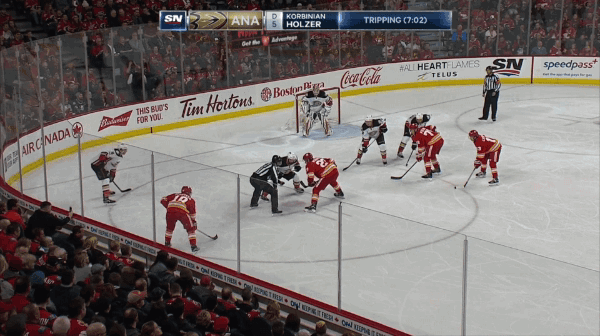
With Fowler being harassed by Versteeg and Ferland coming in in hopes of gaining possession 42 (Manson) comes in to get position and then possession of the puck and clear it down the ice.
Another example of the team effort is F1 (Thompson) tying up Monahan right after the draw, allowing 17 (Kesler) to immediately clear it down the ice:
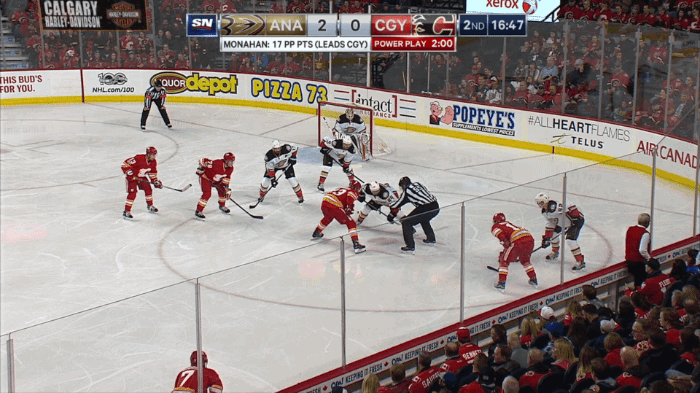
Even when it comes to the Flames getting possession – though incredibly briefly – on a dump and chase entry, the Ducks find a way to box out the Flames’ forwards using positioning on the entry, size, and strength to clear the zone. Fowler is first on the puck after Giordano dumps it in. Theodore supports his partner as Backlund tries to gain possession and set up for the Flames’ 1-3-1 formation. The Ducks outmuscle Backlund and company, allowing Cogliano, who is in prime position, to clear the puck:
Fowler is first on the puck after Giordano dumps it in. Theodore supports his partner as Backlund tries to gain possession and set up for the Flames’ 1-3-1 formation. The Ducks outmuscle Backlund and company, allowing Cogliano, who is in prime position, to clear the puck:
The Flames fare no better on their second entry attempt on the dump and chase which allows the Ducks’ penalty kill to go up ice again. Structurally, the Ducks appear to be pretty capable if they have to play in their own end for a little longer than normal. When it comes to the Ducks’ system and strategy in their own end – if the opposition sets up – they deploy a very similar system to Calgary and other teams in the wedge/triangle +1. When they get aggressive, that transitions into what is called the
Structurally, the Ducks appear to be pretty capable if they have to play in their own end for a little longer than normal. When it comes to the Ducks’ system and strategy in their own end – if the opposition sets up – they deploy a very similar system to Calgary and other teams in the wedge/triangle +1. When they get aggressive, that transitions into what is called the Czech Press:
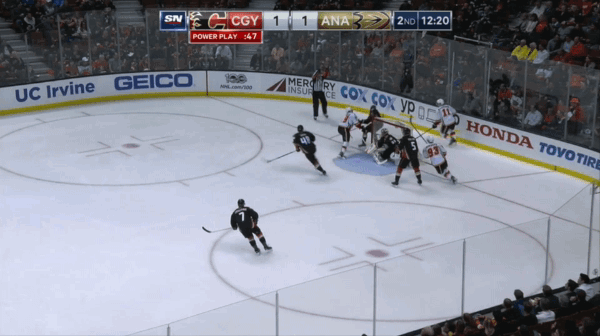
F1 (48 – Shaw) is aggressive, forcing the puck carrier to continue to hand off and cycle the puck. In the case that Giordano drop passes to Hamilton, the +1 would transition to Cogliano to pressure the puck carrier. A lot of the work relies on trigger points like mishandling the puck after a pass, miscues in puck movement, etc.
However, in the example below, we see the +1 not transition, allowing F2 to sink back in after Versteeg gets a pass through:

Fortunately, they’re able to recover the loose puck on the scramble there and clear it down the ice. This is an opportunity itself to capitalize on if a situation arises where the +1 doesn’t change to challenge the puck carrier. The Flames were incredibly close to making it 2-1 here.
You can see how the Ducks pounce on an opportunity when a puck is mishandled here in their game versus Edmonton, which falls in line with how the Czech Press can be used to break up the formation and force the puck out of the zone:
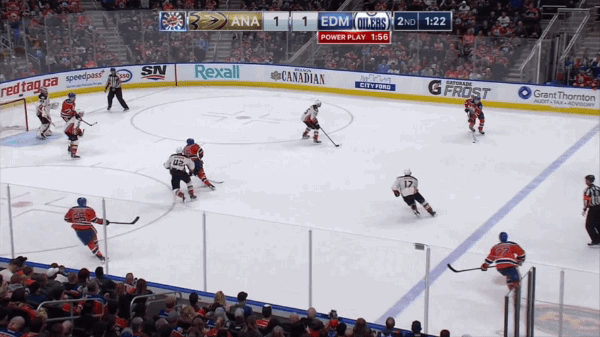
Summing it all up
The way this reads it might come off like Anaheim is unstoppable at 4v5, which is not the case. If Dave Cameron and Gulutzan can add a bit more to the power play – specifically creating two units that are composed of the right components – then it’s possible for the Flames to score some 5v4 goals. Part of that is going to come with finding a way to enter the zone with possession, set up, and generate shots.
Finding holes and lapses in the wedge/triangle +1 can give the Flames seams to start ripping apart the league’s fourth-best penalty kill.
Finding ways to draw some of Anaheim’s top penalty killers into the penalty box or forcing them into 5v3 situations is another way to give them an advantage in a series they will need. The Ducks often play incredibly aggressive and it’s evident in their recent games against the Flames. Exploiting that is going to be a huge key if the Flames hope to win this series.
Recent articles from Mike Pfeil





